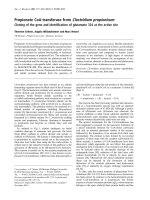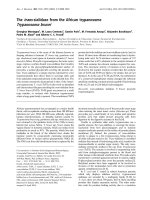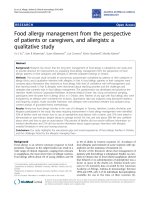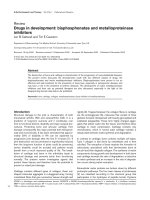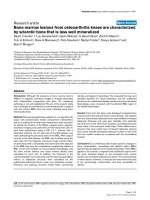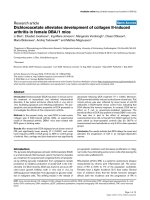Báo cáo y học: "VEGF attenuates development from cardiac hypertrophy to heart failure after aortic stenosis through mitochondrial mediated apoptosis and cardiomyocyte proliferation" potx
Bạn đang xem bản rút gọn của tài liệu. Xem và tải ngay bản đầy đủ của tài liệu tại đây (1.6 MB, 9 trang )
RESEARC H ARTIC L E Open Access
VEGF attenuates development from cardiac
hypertrophy to heart failure after aortic stenosis
through mitochondrial mediated apoptosis and
cardiomyocyte proliferation
Xiao H Xu
†
, Jing Xu
†
, Lei Xue
†
, Hai L Cao, Xiang Liu and Yi J Chen
*
Abstract
Background: Aortic stenosis (AS) affects 3 percent of persons older than 65 years and leads to greater morbidity
and mortality than other cardiac valve diseases. Surgery with aortic valve replacement (AVR) for severe
symptomatic AS is currently the only treatment option. Unfortunately, in patients with poor ventricular function,
the mortality and long-term outcome is unsatisfied, and only a minority of these patients could bear surgery. Our
previous studies demonstrated that vascular endothelial growth factor (VEGF) protects cardiac function in
myocardial infarction model through classic VEGF-PI3k-Akt and unclear mitochondrial anti-apoptosis pathways;
promoting cardiomyocyte (CM) proliferation as well. The present study was designed to test whether pre-operative
treatment with VEGF improves AS-induced cardiac dysfunction, to be better suitable for AVR, and its potential
mechanism.
Methods: Adult male mice were subjected to AS or sham operation. Two weeks later , adenoviral VEGF (Ad-VEGF),
enhanced green fluorescence protein (Ad-EGFP, as a parallel control) or saline was injected into left ventricle free
wall. Two weeks after delivery, all mice were measured by echocardiograph y and harvested for further detection.
Results: AS for four weeks caused cardiac hypertrophy and left ventricular dysfunction. VEGF treatment increased
capillary density, protected mitochondrial function, reduced CMs apoptosis, promoted CMs proliferation and
eventually preserved cardiac function.
Conclusions: Our findings indicate that VEGF could repair AS-induced transition from compensatory cardiac
hypertrophy to heart failure.
Background
Aortic stenosis (AS) is the most common cardiac v alve
disease, affecting about 3 percent of persons older than
65 years. Although t he survival rate in asymptomatic
patients is comparable to that in age- and sex-matched
control patients, the average overall survival rate in
symptomatic patients is 2-3 years [1]. For patients with
severe symptomatic AS, surgical intervention with aortic
valve replacement (AVR) is the only effective treatment
available. Surgical mortality for isolated AVR in those
with normal left ventricular function should be less than
1%. Successful valve replacement results in marked
symptom relief and age-corrected survival bec omes
nearly normal. Yet, patients with AS and depressed ven-
tricular function present high operative mortality and
poor long-term outcome [2].
As the aortic valve area becomes smaller, the
increased afterload on the lef t ventricle (LV) results in
compensatory hypertrophy, which enables it to mainta in
systolic function. However, with time and sustained
severe pressure overload, the LV dilates with impair-
ment of contractile state and subseque nt dysfunction.
Although the molecular mechanisms involved in the
transition from compensated hypertrophy to heart
* Correspondence:
† Contributed equally
Department of Thoracic and Cardiovascular Surgery, The First Affiliated
Hospital of Nanjing Medical University, Nanjing, P. R. China
Xu et al. Journal of Cardiothoracic Surgery 2011, 6:54
/>© 2011 Xu et al; licensee BioMed Central Ltd. This is an Open Access article distributed under the terms of the Creative Commons
Attribution License ( ), which permits unrestricted use, distribution, and reproduction in
any medium, provided the original work is properly cited.
failure are poorly understood, the fundamental hypoth-
esis is that, according to the nat ure of signaling stimu-
lus, the cardiomyocytes (CMs) can either survive,
leading to beneficial hypertrophy, or undergo apoptosis
(programmed cell death), which promotes LV failure
and dilation [3].
Vascular endothelial growth factor (VEGF) is an
endothelial cell mitogen which has been recognized to
have both angiogenenic and nonangiogenic role for car-
diovascular system. VEGF regulates multiple cellular
stress responses, including survival, proliferation, migra-
tion, and differentiation. Our previous studies have
shown that VEGF could facilitate CMs regeneration and
protect it from apoptosis which was related with the acti-
vation of phosphatidylinositol-3 kinase (PI-3K) and the
upregulation of Bcl-2 expression [4]. Recently, Izumiya
et al illustrated that sequestration of endogenous VEGF
impairs adaptive cardiac hypertrophy through markedly
reduced capillary density, increased myocardial fibrosis
and upregulated c ollagen gene [5]. Moreover, Zisa et al
found that intramuscular injection of recombinant
human VEGF stimulates CMs regeneration, production
of growth factors, and mobilization of progenitor cells,
culminating in attenuation of disease progression and
robust repair of the failing heart [6].
Take advantage these features of VEGF, we hypothe-
sized that pre-operative VEGF treatment could improves
the AS patients’ condition, especially those with severe
cardiac hypertrophy, to avoid the worsening of LV func-
tion and better suitable for AVR. Thus, it is important
to test t his hypothesis in an animal model of AS, and
the results may be useful in designing and j ustifying
future clinical trials.
Methods
Animals
The experiment protocols were approved by Animal
Care and Use Committee of Nanjing Medical University.
Ten-week-old male C57BL/6 mice were obtained from
the Experimental Animal Center of Nanjing University
(Nan jing, China). Animals were fed ad libitum standard
mouse food pellets and tap water, and housed in groups
of four to five mice with 12:12 hour light-dark cycles.
Adenoviral-mediated Gene Transfer
Recombinant human adenoviral vectors are the most
efficient gene delivery ve hicles currently used for gene
transfer in preclinical gene therapy models and in clini-
cal cardiovascular gene therapy protocols because of the
ease of their production and the broad cell tropism, par-
ticularly within the cardiovascular system which makes
them widely used in myocardial gene therapy. All major
cardiac cell types can be efficiently tra nsduced by ade-
noviral vectors, both in vitro and in vivo. With regard to
CMs, efficient in vivo transduction has been demon-
strated in gene therapy models from several mammalian
species [7]. In our study adenovirus vectors encoding
VEGF (Ad-VEGF) and control adenovirus vectors
encoding enhanced green fluorescence protein (Ad-
EGFP) fragment were described previously [4]. We
injected 1 × 10
8
plaque-formi ng units of A d-VEGF or
Ad-EGFP into left ventricle free wall two weeks after
aorta ligature.
Design of the study
Mice were randomly subjected to either aorta ligature-
induced AS (n = 40) or sham operation (n = 10). Surgi-
cal mortality rates were 20% or 0%, respectively, for AS
or sham operations. Two weeks after thoracic aortic
constriction (TAC) (compensatory hypertrophy phase in
this model), AS animals underwent midline sternotomy
and further assigned to three groups: i) saline injected
hypertrophied hearts (TAC group), ii) Ad-EGFP injected
hypertrophied hearts (EGFP group), iii) Ad-VEGF
injected hypertrophied hearts (VEGF group). Sham
group mice also did midline sternotomy but no injec-
tion. Two weeks after viral delivery, all mice were exam-
ined by echocardiography and killed. The heart wet
weight to body weight ratio and to tibia length ratio
were calculated. Heart samples were frozen in liquid
nitrogen and then stored at -80°C until analysis. Addi-
tional heart samples were used for electron microscopy
and histological evaluation.
Aortic stenosis model (aorta ligature)
Aortic stenosis was created by aorta ligature in accor-
dan ce with method of transverse a ortic constriction [8].
In brief, mice were anesthetized (with a mixture of 8
mg/100 g ketamine, 2mg/100 g xyl azine, 0.6 mg/100 g
atropine, and the pain reliever temgesic at 0.1 mg/100
g), intubated, and ventilated. Under a surgical micro-
scope, a midline incision was made at the upper ster-
num. The aorta was dissected between the right
innominate and the left carotid arteries and narrowed to
a l umen size of 0.4 mm. Sham mice underwent similar
surgery except for the narrowing of the aorta.
Echocardiography
Two weeks after aorta ligature and viral delivery, the
mice were undergone cardiac function assessment by
transthoracic echocardiography with 12-MHz phased-
array transducer (Hewlett Packard). The heart was
imaged in t he cross-sect ional mode in parasterna l long-
and short-axis views of the LV. Average interventricular
septum diameter (IVSd), LV posterior wall thickness
(LVPW), LV ejection fraction ( LVEF) and LV fractional
shortening (FS) were measured from three consecutive
cardiac cycles. All measurements were done by two
Xu et al. Journal of Cardiothoracic Surgery 2011, 6:54
/>Page 2 of 9
experienced echocardiographer who were blinded to
treatment assignment.
Cardiac Hypertrophy
Tissue samples were taken from left ventricles, fixed
with 4% formalin, embedded in paraffin, and cut into 3
μm thickness. Hematoxylin-eosin (HE) staining were
performed using serial sections. CM cross-sectional area
was measured by tracing the outlines of 100-200 CMs
with a clear nucleus image per each heart using hema-
toxylin-eosin stained sections.
Microvessel Density
For measurement of capillary density, sections taken
perpendicular to the long axis of the LV were immuno-
histochemically stained with a specific primary antibody
against von Willebrand Factor (vWF) (1:100, abcom).
Capillary density was defined as the capillary to cardio-
myocyte ratio.
Cardiomyocyte Proliferation
To dete ct whether VEGF promotes cardiomyocyte pro-
liferation, immunohistochemical analysi s was performe d
for Ki-67 (1:100, Zymed Laboratories). Only nuclei that
were clearly located in cardiomyocytes were counted.
TUNNEL Assay
Apoptosis was determined by termina l deoxynucleotidyl
transferase dUTP nick-end labeling (TUNEL ) assay
using a POD TUNEL kit (Roche, Mannheim, Germany).
Apoptotic nuclei were identified manually to determine
that only apoptotic cardiomyocyte nucle i were included.
The number of TUNEL-positive cells was expressed as a
percentage of total cells.
Western Analysis
The LV tissue was homogenized with lysis buffer (pH
7.4) containing 25 mM Tris, 150 mM NaCl, 5 mM
EDTA, 10 mM sodium pyrophosphate, 10 mM b-glycer-
ophosphate, 1 mM sodium orthovanadate (Na
3
VO
4
), 1%
(vol/vol) Triton X-100, 10% (vol/vol) glycerol, 1 mM
dithiothreitol, 1 mM PMSF, and a protease inhibitor
cocktail (Sigma, St. Louis, MO). The total prot ein
homogenate (20-50 μg) was separated by SDS-PAGE
and transferred onto PVDF membranes. The expression
levels of important signaling molecules, VEGF, and
apoptosis-related proteins wer e detected using an tibo-
dies against OPA1, Bax, Bcl-xL, Akt and p-Akt from
Cell Signaling Technology.
Electron Microscopy
Standard transmission electron microscopy (EM) was
performed as previously described [9]. Digital images of
sequential fields were collected for analysis. To
determine the population and size o f the mitochondria,
the EM images were analyzed with Photoshop CS3,
using the counting and area analysis function, in an
approach similar to that reported by other investigators.
Statistical analysis
Data were analyzed using SPSS software package (Ver-
sion 14.0; SPSS Inc, Cary, NC, USA) and are reported as
mean ± standard error of the mean. One-way ANOVA
was used for comparison among and between groups, or
Kruskal-Wallis test if normality was not passed, followed
by Bonferroni or Dunn post-hoc analysis when ap pro-
priate. Values of P < 0.05 were considered statistically
significant.
Results
Cardiac Function and Morphology
Two weeks after aorta ligature, AS mice displayed the
increased LV posterior wall thickness (LVPW), interven-
tricular septal thickness (IVSd) (P < 0.001) and similar
LV fractional shortening (LVFS), LV ejection fraction
(LVEF) (P = 0.92) compared with sham operated mice,
indicating compensatory cardiac hypertrophy and nor-
mal systolic function (Figure 1). However at two weeks
after adenoviral injection, TAC mice showed a marked
LV enlargement a nd signs of diminished cardiac func-
tion - i.e., reduced LVEF and LVFS (P < 0.01). Treat-
ment with Ad-VEGF prevented the reductions of LVEF
and LVFS (P < 0.05), with no significant difference in
LVPW, I VSd, heart weight/body weight ratio and heart
weight/tibia length ratio, as compared to TAC animals
(Figure 2). Histological evaluation further confirmed
that the cros s-sectional area of CMs increased in theses
three AS groups compared t o sham, although VEGF
treatment had no effect on CMs hypertrophy (Figure
3A, E).
Microvessel Density
Figure 3B shows representative photomicrographs of the
four different groups. Capillary density was significantly
increased in TAC compared to s ham group (P < 0.05).
VEGF treatment revealed an augmentation of neovascu-
larization after induction of AS. In the VEGF group we
observed a 45% increase in capillary density relative to
TAC group (P < 0.01). The differences between TAC
and EGFP group were not statistically significant.
Cardiomyocyte Apoptosis
The number of TUNEL positive cells was significantly
higher in mice with AS, compared to sham (P <0.05,
Figure 3C). Treatment with VEGF resulted in a 66%
reduction apoptotic CMs (P < 0.01). However, the num-
bers of TUNEL positive cells did not differ significantly
between the TAC and EGFP groups.
Xu et al. Journal of Cardiothoracic Surgery 2011, 6:54
/>Page 3 of 9
Cardiomyocyte Proliferation
Immunostaining for the cell proliferation marker Ki-6 7
was used to confirm VEGF-induced CM s regeneration.
Induction of AS resulted in a 2 fold increased in the
expression of Ki-67 in the TAC group (Figure 3D).
VEGF significantly promoted CMs proliferation by
approximately increased 3 fold as many Ki67 positive
nuclei as TAC group (P < 0.01). A dditionally no signifi-
cant difference was found between TAC and EGFP
group.
Mitochondrial Morphology and Function
EM was used to analyze mitochondrial fission and
fusion changes in AS induced heart failure. The mito-
chondria in the TAC mice heart were disorganized and
smal ler (Figure 4A). The absolute number of mitochon-
dria pe r area was significantly increased and the indivi-
dual mitochondrial cross-sectional areas were
significantly decreased as compared to sham group.
VEGF injection significant decre ased the absolute num-
ber of mitochondria per a rea and incre ased the indivi-
dual mitochondrial cross-sectional areas (P < 0.05,
Figure 4B). Expression of OPA1, a mitochondrial fusion
protein, was d ecreased in TAC group, as observed b y
western blotting, which would be seen with a loss of the
fus ion/fission balance. VEGF improved the reduction of
OPA1 expression (Figure 4C, P < 0.05), this suggests an
important role for OPA1 in the progressive deterioration
of the failing heart. Meanwhile the mitochondrial
apoptosis pathway regulation proteins Bcl-xL and Bax
were also detected by western blotting. The up-regula-
tion of Bcl-xL and down-regulation of Bax expression
further substantiated the anti-apoptosis effect of VEGF
(Figure 4D, E, P < 0.05).
In Vivo VEGF and Phosphorylated Akt Expression
After 2 weeks injection of adenovirus containing VEGF
in hypertrophied hearts, western blot analysis showed
that levels of VEGF were increased in VEGF group com-
pared with that in other groups (Fig 5A, P <0.05).To
investigate whether VEGF could activate PI3K-Akt sig-
naling in the myocardium, we examined the level of
phospho-Akt and Akt in the myocardium. As shown in
Figure 5B, sign ificant increase in the ratio of phosphor-
Akt/Akt was observed in the VEGF group compared
with that in other groups (P < 0.05). Thus, Ad-VEGF
injection increased expression of VEGF and phospho-
Akt in myocardium.
Discussion
AS-induced LV hypertrophy is an initially expected
response in order for the CMs to generate additional
force to overcome the increase in pressur e load. The
initial response may become decompensated when CMs
degenerate as a result of inflammatory response, oxida-
tive stress, apoptosis, fibrosis and progressive LV dila-
tion with a progressive decline in cardiac pump
function. In the present study, we found that two weeks
Figure 1 Two weeks aortic ligature results in cardiac hypertrophy and normal cardiac function. A, Repre sentative transthoracic M-mode
echocardiogram for sham and TAC mice B, IVSd, LVPW, and LVFS data between sham and TAC mice.
Xu et al. Journal of Cardiothoracic Surgery 2011, 6:54
/>Page 4 of 9
AS mice presented cardiac hypertrophy and normal car-
diac function. Whereas, at 4 weeks after aorta ligature,
remarkable pulmonary congestion and LV dysfunction
were exhibited in the TAC mice, underwent a transition
from compensatory cardiac hypertrophy t o heart failure.
VEGF injection in compensatory hypertrophy heart was
found t o attenuate LV remodeling and to improve car-
diac function through increased capillary density, pre-
served mitochondrial function, promoted CMs
proliferation, as well as reduced CMs apoptosis.
It is well known that myocardial apoptosis has been
shown to be a critical determinant of unfavorable
LV remodeling and play an important role in the
progression of AS. However the underlying mechanisms
by which the heart loses CMs in heart failure are not
completely understood [3].
One important component of the myocardial remodel-
ing process is neoangiogene sis. After AS, neoangiogen-
esis is normally unable to compensate for the blood
supply and to support t he tissue growth required for
contractile compensation and the greater demands of
the hypertrophied myocardium; this may contribute to
the death of myocardium, leading to progressive CMs
apoptosis and secondary fibrosis replacemen t. Our study
suggested an increase in angiogenesis in VEGF animals,
and this may contribute importantly to the reduction in
Figure 2 Ad-VEGF treatment improves heart function at two weeks after viral delivery. A, Representative photographs of the hearts for
sham, TAC, EGFP and VEGF mice B, Representative transthoracic M-mode echocardiogram for sham, TAC, EGFP and VEGF mice C, IVSd, LVPW,
LVFS, ratios of heart weight to body weight and heart weight to tibia length data for sham, TAC, EGFP and VEGF mice. *P < 0.05, TAC vs. Sham;
†P < 0.05, VEGF vs. TAC.
Xu et al. Journal of Cardiothoracic Surgery 2011, 6:54
/>Page 5 of 9
Figure 3 VEGF overexpression exerts increased capillary density, reduced CMs apoptosis, promoted CMs proliferation two weeks after
viral injection. A, Representative histological micrographs of the LV myocardium stained with hematoxylin-eosin B, vWF immunostaining to
identify capillary density C, Histological identification of apoptotic CMs for TUNEL D, Ki-67 staining to detect CMs proliferation E, Quantitative
analysis of the cross-sectional area of CMs, and ratios of capillary, TUNEL positive nuclei and Ki-67 positive nuclei to myocyte in LV myocardium
(Bars = 100 μm). *P < 0.05, TAC vs. Sham; †P < 0.05, VEGF vs. TAC.
Xu et al. Journal of Cardiothoracic Surgery 2011, 6:54
/>Page 6 of 9
remodeling and apoptosis. Ferrata [10] demonstrated
that VEGF could control the recruitment of endothelial
progenitor cells and facili tate the proliferation of
endothelial cells. Additionally Alon et al. [11] found that
VEGF as a mitogen for vascular endothelial cells is cru-
cial for vascular development and endothelial cell survi-
val. In our model, therefore, we would predict that
Ad-VEGF injection may enhance LV local VEGF expres-
sion, protect endothelial cells, promote endothelial pro-
genitor cell recruitment, and improve vascular
development, resulting in enhanced angiogenesis.
Mitochondria also have a critical role in regulating
apoptosis. CMs function at a high metabolic state,
requiring large amounts of high-energy phosphates, and
Figure 4 VEGF injection maintains mitochondrial fission and f usion balance and protects mitochondrial regulated apoptosis two
weeks after viral injection. A, Representative EM for sham, TAC, EGFP and VEGF mice heart B, Graphs summarize the mitochondria per area
and average mitochondrial size C, D, E, Representative Western blots and the results of quantitative analysis for OPA1, Bax and BcL-xL protein
expression. *P < 0.05, TAC vs. Sham; †P < 0.05, VEGF vs. TAC.
Xu et al. Journal of Cardiothoracic Surgery 2011, 6:54
/>Page 7 of 9
as a consequence, mitochondria are abundant in these
cells [12,13]. Mitochondrial fission and fusion, described
recently and most extensively in dilated cardiomyopathy
and ischaemic cardiomyopathy, occur constantly and are
thought to be critical for normal mitochondrial function
[14]. If fission is interrupted, large networks of fused
mitochondria occur. If fusion fails, become small and
fragmented. Abnormalities in fission and fusion can lead
to apoptosis, which is an important mechanism of CMs
loss in heart fai lure [15-17]. OP A1 is a mitochondrial
fusion protein which is important for maintaining nor-
mal cristae structure and function, for preserving the
inner membrane structure and for protecting CMs from
apoptosis. As shown in our study, 4 weeks after AS, the
mitochondria of CMs become small and dysfunctional,
this is similar with early studies on DCM and ICM.
VEGF treatment maintained mitochondrial fission and
fusion balance, increased the expression of inhibiting
apoptosis proteins OPA1 and Bc l-xL, decreased the
expression of promoting apoptosis protein Bax, leading
to prevention mitochondrial apoptotic regulated
pathways.
Phosphoinositide 3-kinase and its d ownstream target
serine/threonine kinase Akt are also recognized as
another most critical pathways in regulating CMs
activation, inflammatory responses and apoptosis
[18,19]. Activation of PI3K/Akt-dependent signaling has
been shown to prevent CMs apoptosis and protect the
myocardium [20]. Our result s found that the level of
phosphor-Akt was elevated and the apoptosis of myo-
cardium was reduced in VEGF group compared with
that in TAC g roup. So we demonstrated that the eff ect
of VEGF was mediated partially through the PI3K/Akt-
dependent anti-apoptotic mechanism.
In current, myocardial regeneration has become the
hotspot and challenge of clinical treatment for heart fail-
ure. It may offer possibilities that could supplement
apoptosis-conduced CMs shortage and maintain the
absolute numbers of CMs, as well as improve cardiac
function. Evidence is accumulating to suggest that
VEGF exerts potent pleiotropic effects on the myocar-
dium in the setting of acute myocardial infarction a nd
chronic heart failure as well. In our previous study we
demonstrated that overexpression VEGF could mobilize
marrow stem cell and accelerate CMs regeneration in
myocardial infarction model [21]. Furthermore Zisa et
al. [6] shown that VEGF stimulated proliferation, mig ra-
tion, and growth factor production of CMs, which pro-
vides evidence for CMs regeneration and progenitor cell
expansion. Our results indicate that a significant effect
Figure 5 Ad-VEGF increases expression of VEGF (A), p-Akt (B) protein two weeks after viral injection.*P < 0.05, TAC vs. Sham; †P < 0.05,
VEGF vs. TAC.
Xu et al. Journal of Cardiothoracic Surgery 2011, 6:54
/>Page 8 of 9
of VEGF injections ca n be attributed to enhanced CMs
proliferation in the myocardium following AS. Conse-
quently, we could forecast that VEGF may contribute to
mobilize bone mar row stem cells and promote stem
cells differentiation into CMs and endothelial cells. Dif-
ferentiated CMs render it possible that reenter the cell
cycle and recommence proliferation. Additionally VEGF
may give rise to reduce apoptosis of viable CMs, thereby
contributing to CMs proliferation. However, the precise
mechanisms of VEGF-induced CMs proliferation need
to be evaluated in further studies.
Conclusions
In summary, the results of the present study using the
mouse model of AS bear out the cardioprotective,
angiogenic, proliferative, and anti-apoptotic effects of
VEGF and its possible molecular mechanism. It is
known that reduced LV ejection fraction and increased
LVcavitysizebeforeAVRareassociatedwithpoor
postoperative recovery. Although the correlation to
human or clinical data remains to be proved, it is our
anticipation that the number of AS patients who are sui-
table for AVR will be increased, the mortality following
AVR will be decreased, and postoperative recovery will
be improved if VEGF pre-operative treatment can b e
demonstrated to be effective in clinical trials.
List of abbreviations
AS: Aortic stenosis; AVR: Aortic valve replacement; VEGF: Vascular endothelial
growth factor; CM: Cardiomyocyte; Ad-VEGF: Adenoviral VEGF; Ad-EGFP:
Adenoviral enhanced green fluorescence protein; LV: Left ventricle; PI-3K:
Phosphatidylinositol-3 kinase; IVSd: Interventricular septum diameter; LVPW:
LV posterior wall thickness; LVEF: LV ejection fraction; FS: LV fractional
shortening; HE: Hematoxylin-eosin; vWF: Willebrand Factor; TUNEL: Terminal
deoxynucleotidyl transferase dUTP nick-end labeling; EM: Electron
microscopy.
Acknowledgements
This work was supported in part by the National Natural Science Foundation
of China (30872544); Jiangsu Province Natural Science Foundation
(BK2006248); Jiangsu Province Import Foreign Talent Program Grant
(S2008320072); Jiangsu Province Health Department Program Grant
(H200821) and Jiangsu Top Expert Program in Six Professions (06-B-031).
Authors’ contributions
XHX, JX and YJC participated in the design of the study and coordination,
LX and HLC participated in the data collect and modified the manuscript, XL
performed the statistical analysis and helped to draft and modified the
manuscript. All authors read and approved the final manuscript.
Competing interests
The authors declare that they have no competing interests.
Received: 14 February 2011 Accepted: 16 April 2011
Published: 16 April 2011
References
1. Pellikka PA, Sarano ME, Nishimura RA, Malouf JF, Bailey KR, Scott CG,
Barnes ME, Tajik AJ: Outcome of 622 adults with asymptomatic,
hemodynamically significant aortic stenosis during prolonged follow-up.
Circulation 2005, 111:3290-3295.
2. Grimard BH, Larson JM: Aortic stenosis: diagnosis and treatment. Am Fam
Physician 2008, 78:717-724.
3. Opie LH, Commerford PJ, Gersh BJ, Pfeffer MA: Controversies in ventricular
remodeling. Lancet 2006, 367:356-367.
4. Zhou L, Ma W, Yang Z, Zhang F, Lu L, Ding Z, Ding B, Ha T, Gao X, Li C:
VEGF165 and angiopoietin-1 decreased myocardium infact size through
phosphatidylinsostitol-3 kinase and Bcl-2 pathways. Gene Ther 2005,
12:198-202.
5. Izumiya Y, Shiojima I, Sato K, Sawyer DB, Colucci WS, Walsh K: Vascular
endothelial growth factor blockade promotes the transition from
compensatory cardiac hypertrophy to failure in response to pressure
overload. Hypertension 2006, 47:887-893.
6. Zisa D, Shabbir A, Mastri M, Suzuki G, Lee T: Intramuscular VEGF repairs
the failing heart: role of host-derived growth factors and mobilization of
progenitor cells. Am J Physiol Regul Integr Comp Physiol 2009, 297:
R1503-1515.
7. Njeim MT, Hajjar RJ: Gene therapy for heart failure. Arch Cardiovasc Dis
2010, 103:477-485.
8. Hu P, Zhang D, Swenson L, Chakrabarti G, Abel ED, Litwin SE: Minimally
invasive aortic banding in mice: effects of altered cardiomyocyte insulin
signaling during pressure overload. Am J Physiol Heart Circ Physiol 2003,
285:H1261-1269.
9. Gupta S, Knowlton AA: HSP60, Bax, apoptosis and the heart. J Cell Mol
Med 2005, 9:51-58.
10. Ferrara N: Role of vascular endothelial growth factor in regulation of
physiological angiogenesis. Am J Physiol Cell Physiol 2001, 280:C1358-1366.
11. Alon T, Hemo I, Itin A, Pe’er J, Stone J, Keshet E: Vascular endothelial
growth factor acts as a survival factor for newly formed retinal vessels
and has implications for retinopathy of prematurity. Nat Med 1995,
1:1024-1028.
12. Chan DC: Mitochondria: dynamic organelles in disease, aging and
development. Cell 2006, 125:1241-1252.
13. Chan DC: Dissecting mitochondrial fusion. Dev Cell 2006, 11:592-594.
14. Chen L, Gong Q, Stice JP, Knowlton AA: Mitochondrial OPA1, apoptosis,
and heart failure. Cardiovasc Res 2009, 84:91-99.
15. Lee Y, Jeong S, Karbowski M, Smith CL, Youle RJ:
Roles of mammalian
mitochondrial fission and fusion mediators Fis1, Drp1 and OPA1 in
apoptosis. Mol Biol Cell 2004, 15:5001-5011.
16. Cassidy-Stone A, Chipuk JE, Ingerman E, Song C, Yoo C, Kuwana T,
Kurth MJ, Shaw JT, Hinshaw JE, Green DR, Nunnari J: Chemical inhibition
of the mitochondrial division dynamin reveals its role in Bax/Bak-
dependent mitochondrial outer membrane permeabilization. Dev Cell
2008, 14:193-204.
17. Hilfiker-Kleiner D, Landmesser U, Drexler H: Molecular mechanisms in heart
failure: focus on cardiac hypertrophy, inflammation, angiogenesis, and
apoptosis. J Am Coll Cardiol 2006, 48:A56-66.
18. Dimmeler S, Zeiher AM: Akt takes center stage in angiogenesis signaling.
Cric Res 2000, 86:4-5.
19. Brazil DP, Hemmings BA: Ten years of protein kinase B signalling: a hard
Akt to follow. Trends Biochem Sci 2001, 26:657-664.
20. Lim SY, Kim YS, Ahn Y, Jeong MH, Hong MH, Joo SY, Nam KI, Cho JG,
Kang PM, Park JC: The effects of mesenchymal stem cells transduced
with Akt in a porcine myocardial infarction model. Cardiovasc Res 2006,
70:530-542.
21. Liu X, Chen Y, Zhang F, Chen L, Ha T, Gao X, Li C: Synergistically
therapeutic effects of VEGF165 and angiopoietin-1 on ischemic rat
myocardium. Scand Cardiovasc J 2007, 41:95-101.
doi:10.1186/1749-8090-6-54
Cite this article as: Xu et al.: VEGF attenuates development from cardiac
hypertrophy to heart failure after aortic stenosis through mitochondrial
mediated apoptosis and cardiomyocyte proliferation. Journal of
Cardiothoracic Surgery 2011 6:54.
Xu et al. Journal of Cardiothoracic Surgery 2011, 6:54
/>Page 9 of 9
